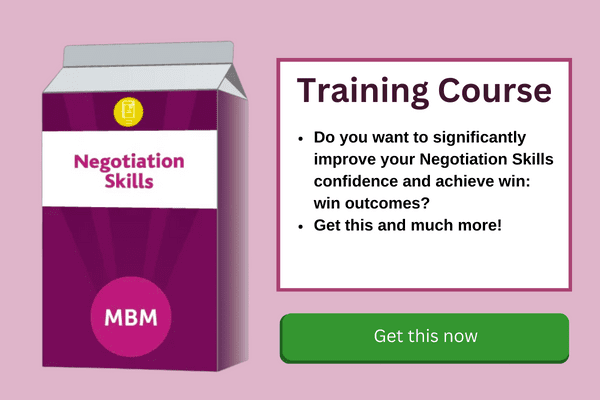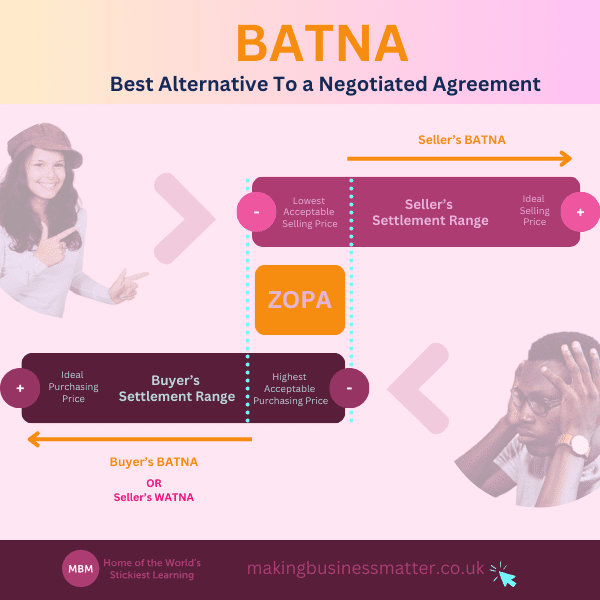Your Best Alternative To a Negotiated Agreement
Everyone in business, regardless of their industry, needs to have effective negotiation skills. We negotiate throughout our careers with some ending more successfully than others. Therefore, it is important to enhance your skills for better results. This is where we need to know about and be able to use BATNA.
This article aims to achieve the following:
- Create an understanding of what BATNA is and where it originated from
- How to use BATNA with examples
- The Importance of BATNA in Negotiations
- The advantages and limitations of using BATNA

Meaning and Origin of BATNA
BATNA is an acronym for Best Alternative To a Negotiated Agreement. As the first A indicates, it’s basically about having a plan B when going through the negotiation process. Not every negotiation will be successful with the first option, therefore, we need to keep our options open.
The term originated in 1981 in a book by Roger Fisher and William Ury called “Getting to Yes: Negotiating Agreement Without Giving In”. We understand from the book’s explanation that BATNA is the best option a party will fall back on if negotiations initially fail. Since being introduced, this practice has been applied to all forms of negotiations, including mergers, property sales, contracts, promotion packages, etc.
Importance of BATNA in Negotiations
There are a number of reasons why understanding and using BATNA in negotiations is important. We need this skill to:
- Walk away from a bad deal if the BATNA is not met. Here, you set your limits about what you will and won’t accept to achieve a successful end to the negotiations.
- Have effective bargaining power at the negotiation table. So, you have room to manoeuvre with having these limits set in place.
- Avoid unnecessary business costs while negotiating. Better preparation will save time and money when the negotiations start.
- Clarify your reservation point that you will not cross. Here, we set our minimum limit that we will not pass.
Basically, you need to have your BATNA prepared in advance before entering into any negotiations. By having this ready in advance, you know what to expect if the first round of talks doesn’t go to plan.

Terms to Understand with BATNA
Before we look at how to use BATNA and share examples, we need ot explain some additional terms that come into play with this particular skill.
-
Do your learners come back from training and do nothing differently?
Sticky Learning ® is 7 times more effective than 1-day training courses. Plus, you will get a Chain of Evidence proving your Return on Investment. Discover soft skills training that changes behaviours long term.
Get Started Now
WATNA
Similar to BATNA, it’s another alternative that you need to consider. However, this time we see Worst Alternative To a Negotiated Agreement. This is the final or lowest offer you would consider during the negotiations. This is also referred to as the reservation value. Here, we ensure that the value we set will still meet your basic needs without suffering a loss or compromising your requirements.
This is the Zone Of Possible Agreement. This is the area where we see an overlap between the buyer’s and seller’s options. It includes any point where an agreement could be reached between these 2 parties. This zone allows the negotiations to continue as both parties are willing to work within these parameters.
Click the image below for a larger version:

When to Use BATNA in Negotiations.
You negotiate throughout your business and personal dealings. Here are some examples where BATNA can be useful when negotiating. Use it to:
- Negotiate a merger for your company.
- Establish an agreed sale/buying price for an item, such as a car, house, etc.
- Work out a hiring or promotion package that meets your needs and expectations.
- Agree on changes to company policies and processes that impact the team.
- Renegotiate existing policies such as insurance, etc.
As you can see, BATNA is used in multiple areas, not just financial transactions.
4 Steps for Using This Negotiation Skill
But, how does it actually work? Let’s break it down so we understand it better.
There are important considerations to take to properly prepare your BATNA for negotiating.
1. Identification
First, you need to understand all of the options that you are willing to consider should the negotiation reach a stalemate.
Next, analyse all of these options carefully. Consider all of the advantages and disadvantages linked to each option.
Now, look for the most profitable option that meets your needs in the negotiation. This way, you have identified the best possible alternative that suits your requirements.
2. Consider The Other Party’s Hand
Negotiations are not just about your options and what you consider to work for you. Actually, they always involve a minimum of 2 parties. Therefore, it is important that you give some consideration to what their BATNA may be. Put yourself in their shoes.
3. Avoid Confusing Your BATNA with Your Reservation Value
It is important to ensure that you have 2 different values for your BATNA and your reservation value. Keep some distance between the 2. This gives you room to manoeuvre during the negotiations. Remember, the reservation value is the lowest possible offer you would consider for the deal to move forward.
4. Be Ready for the Options in Your ZOPA
Although you want to aim for your BATNA, that may not always be achievable. Instead, as we mentioned above, be ready to move around in your zone of possible agreement (ZOPA) to solidify a final agreement. We consider other options and offers in this zone.
Now, let’s have a look at some advantages and limitations of using BATNA during negotiations.

Advantages
Here, let’s look at some different advantages when using BATNA.
- This strengthens your negotiating position.
- You have the expert knowledge from your analysis to support your BATNA decision.
- Your reservation value allows for further wiggle room.
- It allows for further discussions should the original negotiation stall.
- You are guaranteed a backup plan by having a well-prepared BATNA during the process.
- The negotiations can continue to progress even if the first talks were unsuccessful.
Disadvantages
There are several limitations to be aware of.
- The process is complex and time-consuming. Here, keep in mind the investment of time and effort that is involved.
- You run the risk of selecting the wrong choice (BATNA) without proper analysis.
- Your decision is made without the exact knowledge of what the other party is considering.
- Some might forget the reservation value and end with a result that does not meet the needs of you or the company. This can be due to pressure from the other side, intimidation, or lack of confidence from the negotiator. Select your negotiator carefully for better results.
Examples of Using BATNA
So, let’s have a look at some examples of BATNA in action. This way we can better understand how to use it effectively.
#1: Selling your Car
Here, let’s look at the example that you’re selling your car. Decide on the maximum and minimum price you will accept for the purchase of the car. Communicate your top price in adverts about the sale. That way, you save time later instead of wasting time with people bidding too low.
Click the image below for a larger version:

For example, if you want a minimum of $4,000 for your car, this is your reservation value. However, your BATNA is $5,500. Promote the $5,500 as your minimum in your advert. That way, your negotiations start at this point with room for movement. Keep the option of your reservation value with you for now. You receive an offer for $3,750. Therefore, you move forward with further discussions to try to meet your reservation value, as a minimum. Now, consider multiple offers, no need to settle for the first offer, unless it falls into your ZOPA (Zone Of Possible Agreement). Ideally, you will receive an offer that meets your BATNA needs. However, be ready to compromise in your zone of possible agreement to complete the sale.
In the end, you look at meeting the minimum value that you need in order to agree to any sale. Avoid being intimidated by buyers who put pressure on you to sell. Remember, you have your minimum sale amount. Keep that amount in mind throughout the negotiations.
#2: Hiring Package
You are selected for a position with a new company. Now, you want to ensure that you get a deal that meets your needs. Here, ensure you are realistic in terms of your expectations. Refer back to previous packages you had for similar roles. Know here what the overall package should include. This may include travel or meal expenses, overtime, annual or performance bonuses, etc. Also, do market research to see what the common average in this type of role, or similar, is in terms of salary and other benefits.
Ensure you are open to the decisions with the hiring party. Their budget may be different from companies you have worked for in the past. However, know what your reservation value is. Therefore, your minimum requirements are definitely met. Consider your rent/mortgage, loans, and other expenses that you are financially responsible for. Also, keep in mind additional benefits that come with the overall package. Depending on what they are, these can be game changers.
I know from personal experience how important these negotiations can be for everyone, especially a parent or someone who is responsible for others within their family, perhaps an older relative. I also know that non-monetary benefits can help make a big difference in the decision-making process. These added benefits can reduce costs along the way and help with the attractiveness of the package as a whole.
#3: Changing Monetary Policy in the Company
Here, from experience, I can say that the parties involved are usually the executive leadership team, the finance department and HR. Very often, junior staff or others in the company have no idea that these negotiations are even happening until after the fact. So, let’s see how it works.
First, each party must understand what the current policy includes. Have you been giving cash or monetary benefits that need to change? Are these benefits going to be positive or negative for those involved?
Next, they look at what changes are possible or required. This could be an increase or decrease in benefits available for staff. When it is a change that will remove existing benefits, the parties involved need to be careful to consider the impact this can have on those involved.
We saw this happening a lot as a result of Covid-19. Many companies were forced to reduce or remove certain company benefits for the purpose of saving jobs or protecting the company in general. Hopefully, most have reinstated their previous policies or even improved on them since that time.
Here, ensure you focus on the needs and expectations of the staff. Look at possible alternatives that can have a positive impact on the staff while considering the financial impact. Also, once a decision is made, communicate these new policy details effectively. You want to create proper understanding and positivity around the changed policy.
Important Negotiation Skills
In order for you to succeed in any negotiation, you need certain skills.
- Confidence: Everyone involved needs to be confident in their position at the negotiating table.
- Flexibility: Here, your BATNA and ZOPA are in play. This is where there is room for movement for both parties.
- Preparation: Approach every negotiation, no matter how big or small, with proper planning and preparation.
- Active Listening: Be ready to hear what the other party(ies) have to say.
- Decision-making: Be ready to make a decision that best suits your needs. This can include walking away from the negotiation table if your minimum requirements are not met. Have the ability to make those tough decisions.
- Compromise: Very often, meeting in the middle is the best win-win result for everyone involved. Therefore, compromise with the others involved, where necessary.
These skills assist us throughout the negotiation process to achieve the best possible results. Enhance these skills through practice and experience for better use. Ensure you continue to work on these skills and work with others in your team on these same skills.
Finally…
So, there you have it. BATNA is a very useful tool when negotiating. You need to remember to T.A.L.K. for effective use of this tool.

T- Think “Plan B”
Not every negotiation will succeed on the first try. Therefore, have a plan B. That is what BATNA is all about. This ensures that discussions can continue past the first hurdle. Be ready with other options. Have a level of flexibility in your choices. This gives you a better chance for success.
A- Analyse All Options
To get the best BATNA, you need to evaluate all of the options available. Proper analysis needs to be done in order to have the best possible BATNA in place. Do proper identification of all available options before settling on your minimum and maximum values.
L- Learn To Have Confidence
Negotiations are not always easy. Sometimes, you need to stand your ground to ensure you get what you expect. This can be a contract package, a sales price, or other negotiated results. Regardless of the reason, you need confidence to take part in any type of negotiation. One way to have better confidence is to be prepared. This preparation will ensure you can speak more confidently about your position and what you hope to achieve from the negotiations.
K- Know Your Limits
Remember, you have to set your reservation value. This is your lowest limit in your negotiation. Do not consider options that do not meet this minimum setting. Otherwise, you will not meet your basic requirements.
We hope this article has given you useful information about what BATNA is and how and why to use it. Best of luck moving forward with your negotiation skills and experiences.
Remember to engage with us on LinkedIn.





